You can go to a book store and find many books on body-language, communication and persuasion. Many of them seem to cover the same material though: posture, gestures, words that work, etc. Sometimes you can find a book or a blog like AJ’s that has unique insights and applications to help you get better at communicating and persuading.
So, where, besides AJ’s blog, can you get good information that not a lot of people have access to, which will help you understand what other people are thinking and experiencing? This information, of course, would help you become a better persuader. You can also use a system like the Mojo Dialer to increase your contacts when you’re trying to persuade people over the phone.
Thirty years ago, Paul Ekman did cross-cultural research and identified seven basic human emotions. He identified the seven basic emotions through facial expressions. No matter where in the world, what culture, class, race, gender, or lighting, these seven facial expressions were identified across the board. By learning to identify these seven basic human emotions, you will get insight into just what people are experiencing.
The Seven Basic Facial Expressions:
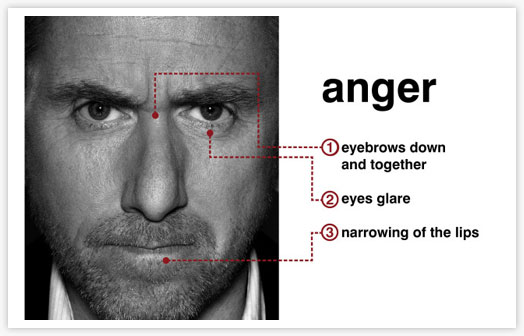
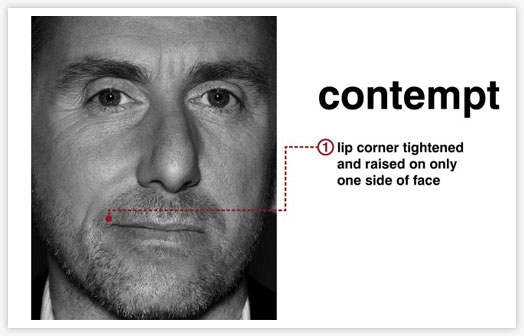
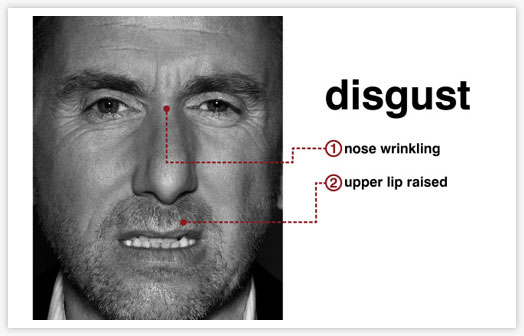
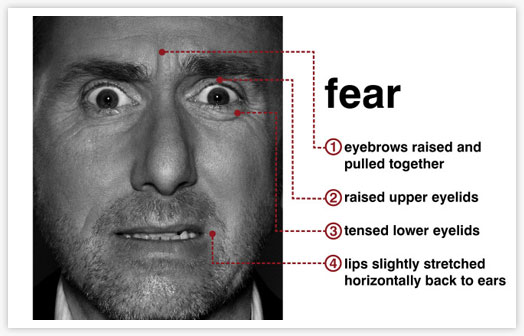
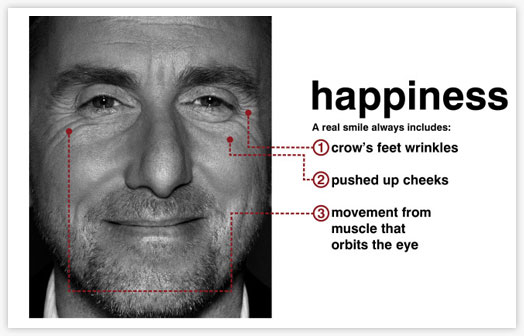
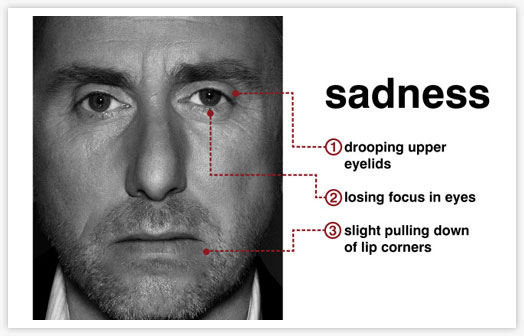
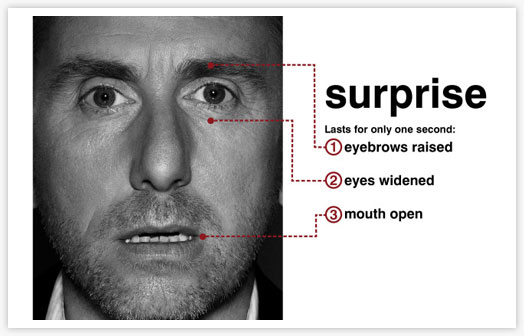
(Pictures are from FOX’s new show LIE TO ME)
These emotions are displayed based on how the muscles in your face move. While researching the face, Ekman created a coding system to identify all of the possible movements that each of you facial muscles can make called the Facial Action Coding System. You don’t have to become an expert in the FACS to read faces though. Ekman offers a nice set of tools to help you better identify people’s facial expressions in real-time.
On his website, you can view a few video interviews that he has done over the years analyzing and explaining his reading of faces. These videos are great both as training tools to understand the range and depth of information that faces present. They also give you a great insight into how you can use facial recognition to more accurately read a person’s emotional state, both the subtle emotions people experience and the emotions they don’t want you to see.
Training Yourself To Notice Facial Expressions
Mr. Ekman has created two training modules that can help you identify these seven basic facial expressions with more precision and ease. It is relatively easy to identify these facial expression when we are shown a picture, but people don’t usually wear their expressions for minutes at a time! On his website, you can use his training videos to identify what he call micro-expressions and subtle-expressions.
Subtle expressions
Subtle expressions happen when someone experiences an emotion very briefly or when the emotion is not as intense. The subtle expression training tool shows you how to recognize the subtle movements in a person’s facial muscles that correspond with various emotions.
Microexpressions
Micro expressions occur when a person is trying to suppress or repress an emotion. Have you ever tried to not smile, or not look angry? In the show Lie To Me, the main character deals with people who are constantly trying to hide their emotions. This training enables you to read a person’s emotional state, even when they don’t want you to!
Using these two training programs will not only help you read ‘pure emotions’, but you will also learn to notice when someone displays conflicting emotions, as in where they’re not sure what to think or feel about something. Mixed emotions are displayed by people when they have two contrasting emotions. Because people can experience more than one emotion at a time, our faces sometimes give off mixed signals. For a brief instant, someone may smile with their mouth at a joke and at the same time display anger with their brow.
Lie to Me
The show Lie to Me on Fox is actually an application of Paul Ekman’s work. In the show, you will see Cal Lightman (the character of Paul Ekamn played by Tim Roth) help private individuals, companies and government investigators find out the truth behind a situation. By expertly reading the expressions of the people he interviews, he uncovers the story behind the story. The show serves as a great introduction to reading body-language and facial expressions.
If you watch the show (close) enough, you’ll start to recognize the richness of information that people present through their facial expressions. Even after gone through the training tools myself, I find myself watching Lie To Me reruns on Hulu to see more of the subtly in facial expressions.
Further Reading
You can also read Ekman’s books for further information about facial expressions and emotions. I tend to like his training tools literally because they are more visual and real-time than verbal (reading) in their presentation. Also graphic novelist Scott McCloudThe Artists Complete Guide to Facial Expressions for a much more in-depth view of facial expressions. recommends Gary Fagin’s
About the Author: Byron Woodson also blogs on his networking blog Weaving Networks
Good stuff Byron.
But if people are able to control their inner state so they could manipulate with their body language and facial expressions, how would you recognize,if they are faking or not?
Because micro-expressions cannot be manipulated and therefore are unable to be faked showing you the truth
You have to be better at reading than they are at faking. Also, a few years back I bought Ekman’s Subtle-Expression training tool and his Micro-Expression training tool. They are designed to teach you how to recognize both subtle (small movements) and micro (quick movements) expressions. I think they’re the same thing as what he has now, only in web-based form. If you’re willing to kick out the dough, definitely check them out.
Also, there is one page in Scott McCloud’s book Making Comics that is priceless because it shows you emotions in different intensities, as well as how the basic emotions combine to form more complex emotions.
Another resource to use is Gary Faigan’s book The Artist’s Guide to Facial Expression, which actually informs Scott McCloud’s work.
I’m writing an essay about the effectiveness of micro expression training, and I am looking for people who have had the training and how they feel about it afterwards. If it is not to much trouble could you tell me about how you feel about you’re skills of detection now and if you have had instances in which you could test that believe about you’re skills?
they are a few ways;
micoexpressions are universal and it is extremely hard to hide 100% of it they will always be a trace of them but there is only one case where you cant see them is if the person has botox.
to know more just go on the wiki page of FACS (facial action coding system) so every facial movement is coded by a number:1=inner brow raised
Hey Andrea,
That's what an actor is. lol. The truth is that you cannot. Although chances are that there would be something called” Leakage” of emotions. Which means that some form of the real emotion they are feeling (even through changing internal states) would still leak out in the form of micro expressions and thel ike.
GREAT article, always interested in this kinda stuff.
That's nice! I was looking for something like that on facial expressions! Thanks!
That's great, then this was perfect for you!
Thanks for the article Byron!
I've been watching Lie to Me for a while to try and pick up some tips on reading microexpressions. The one thing that has made me hesitant about its usefulness though is that fact that the accuracy of the facial expressions portrayed depends solely on the skill of the actors. I doubt even the best actors can properly portray the proper series of microexpressions for conveying each emotion.
Do you think that analyzing shows like this seriously, or even just analyzing any body language shown on tv, is really useful (and not misleading)?
I’m positive that watching these actors at least in this show will tell you a thing or two. Well trained actors have an immense amount of physical and facial control, and you better believe that the people picked for the roles in this are getting/have gotten a whole new level of training.
If you’re going to practice on television, watch talk shows. If you have DVR, put the shows in slow-motion so you can see the subtle changes in their facial expressions as they hear news, other opinions etc. The difficult thing about watching talk shows (springer and crossfire) is the frequent camera angle switches, but putting it in slow motion compensates for that.
Pingback: How to Build Rapport
You are a highly smart person!
Hey bro, I was just moving through the internet Searching for some information and came to your page. I am impressed by the information that you have on this blog. It tells how good you know this topic. I bookmrked this page, I will come back for more reading. You, my buddy, ROCKK!
ohh god. :)). oare de ce…
Temika Costabile
Any idea why your site is loading so slow?
Fantastic. Are you going to keep writing articles? I read all your posts. BTW how did you make the little widget on top of your blog ? Thanks. But.. it has been very slow to load lately.
THANK YOU !! For this amazing post !
Not one web site in google was any help on this stuff… the power of blogging !
Thanks so much I saved the entire thing !
Keep up the great work.
Andrea D. Edelman
About a great number of men and women “likes†Character and add it to their facebook accounts and grow to be fans.
I was doing this before I even knew it. I guess this is the reason why I prefer talking to people face to face. This is something that I could learn further coz based on these studies it far broader than what I put into practice
Pingback: 10 linkuri | Valentin Popescu
Facial expressions are one of the most interesting things about humans.
micro-expressions can be manipulated. Ekman taught himself to move all however many muscles in his face at-will. This means that he can literally express any emotion (and emotional combinations too complex for us rookies) he wants.
Not that i’m attempting to manipulate them, but I’m taking a few minutes a day to close my eyes and change my facial expressions so that i can FEEL what they’re displaying from the inside. This will give me a better sense both of my own emotions as well as what other people can read off of me. i am also spending some time changing my facial expressions by watching them in the mirror.
I’m doing both of these things to be better able to read other people’s overt and subtle expressions as well as get a sense of the physical tension in their face necessary to produce a particular expression. It’s one thing to be able to label an emotion, and another to be able to experience it.
Pingback: Interrupting Someone is Not Rude, It is Persuasive!
i have a girl but cant decipher her help understand facial expression to know her very
I need help decipher this comment
Hello There,
I’m visiting U.S.A on NOV. to have some courses in Body-Language & any other topics that is related to it, and still seeking, found some and searching for more, So please :
1- Do you know any corporates offers this kind of courses on NOV. ?
2- What about the certification ?
3- And the fees ?
4- I’m already a trainer in my country and certified from some arabic corporates, and i want to be certified trainer from an american training corporate to be authorized to give certification from them, so could you help me with that ??
Thanks a lot , I please hope that you replay to me as fast as you can to manage the bookings.
my Email: QATADAH@HOTMAIL.COM
I know two things about my own body language. I know my face twitches when I am fighting not to smile, and I force a yawn when I pass people on the street and feel intimidated. 2 habits that will definitely be corrected soon
Thanks mate great article , i have been studying emotions for sometimes plus just starting in the body language .
still to early for the facial expression cuz spotting micro-expressions needs a very fast dedicated eye or a recorded vid or pics
anyway . . . Thanks for the good article
Pingback: Learning a lot from micro expressions | Elaine Dunhams Notes
yes i am fully interested to learn about human gestures and i want to be updated chronologically about this topic so please make me sure weather i would be able to get further information about gestures and expression… you can send me reply on my mail address
Pingback: Te lo leggo negli occhi… | Illusioni Mentali
i find this subject to be very interesting and hopefully avable to me soon as i get over a head injury. but i dont think much of this will work on psicotic and mental defectives or subjects under control or in pain or under efects of drugs or even under hynosis or a from of stockholem sendrome or just young enff to be convenced that rite is wrong up is down los of inosence
Pingback: How to be a Dominant Alpha Male | Neuro-Linguistic ProgrammingNeuro-Linguistic Programming
Pingback: Interrupting Someone is Not Rude, It is Persuasive! | Neuro-Linguistic ProgrammingNeuro-Linguistic Programming
Hello there, just became aware of your blog through Google, and found that it is truly informative. I am gonna watch out for brussels. I’ll appreciate if you continue this in future. Many people will be benefited from your writing. Cheers!
I think this is among the most vital info for me.
And i am glad reading your article. But wanna remark on few general
things, The website style is wonderful, the articles
is really nice : D. Good job, cheers
my name is mouad and i m really really into this kind of stuff and i wanted to ask you what will be the best training for to be able to understand those facial expression ( book , videos , documents ???) …
The selected affiliates must be those who cater to your target market
because they will be more involved with marketing your products or services.
Usually though, off hours staff are there in a technical support capacity only.
As more people and businesses become comfortable with the internet,
the marketing landscape will continue to evolve quickly in the coming years.